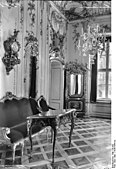Johann Christian Hoppenhaupt the Younger
Johann Christian Hoppenhaupt (born August 16, 1719 in Merseburg ; † March 26, 1785 in Berlin ; called the younger , to distinguish it from his older brother Johann Michael ) was a German ornament sculptor and decorator who played an essential role in the Frederician Rococo style .
Life
Johann Christian Hoppenhaupt, who came from a family of builders and sculptors, was the son of the Princely Saxon court sculptor and master builder Johann Michael Hoppenhaupt from Merseburg and his wife Dorothea Catharina, née Hübner. Like his father and his brothers Johann Michael and Moritz Ehrenreich, he learned a craft trade and trained as an ornamental sculptor. In 1740 Johann Christian and his ten years older brother Johann Michael followed the call of Frederick II to the Prussian court, who was looking for all kinds of useful, skilled and useful people, manufacturers and artists to furnish his castles . In the first few years, the Hoppenhaupts worked according to the specifications of the superintendent of the royal palaces and gardens Georg Wenzeslaus von Knobelsdorff and the “Directeur des ornements” Johann August Nahl . When he fled Prussia in 1746 due to excessive workload, Johann Christian Hoppenhaupt received his office and duties.
Under Nahl, he had already participated in the renovations in the Potsdam City Palace, which were continued under his direction for several years. In addition, Friedrich II entrusted him with essential parts of the wood carving work in the Sanssouci Summer Palace , including the wall and ceiling decorations in the study and bedroom in 1746/47 as well as the gilded carvings on alcoves , doors, overhangs and mirror frames in the other rooms. A first construction invoice for work carried out in the summer palace is dated to 1746.
His wall and ceiling ornaments can also be found in the interior furnishings of Frederick II's apartment in the “New Wing” of Berlin 's Charlottenburg Palace and in Monbijou Palace . When Friedrich II had the Neues Palais guest palace built in Sanssouci Park between 1763 and 1769 , Hoppenhaupt the Younger was again involved in a leading position. He designed the decorations for the royal bedroom and dining room, the upper gallery and the theater. He also made wall and ceiling designs for the New Chambers in Sanssouci Park, which were rebuilt between 1771 and 1775 .
In addition to designing the castle rooms, he designed furniture and created wax models for goldsmithing and porcelain for the Royal Porcelain Manufactory in Berlin . There is evidence of a model for a five-part vase set delivered in 1772. Further work is not documented, but can be assigned to him on the basis of his decorative style on various vessels that KPM made in the 1760s.
The decoration style of Johann Christian Hoppenhaupt is characterized by a clearly structured structure of the ornaments, which he aligned symmetrically. In later times he put on the wall surfaces preferably artistic jewelry in naturalistic shapes such as flowers, fruits, animals and figures, which he added to the rocaille . One example is the “Voltaire room” in Sanssouci Palace, which was redesigned in 1752/53, referred to in older descriptions as the “flower chamber”, in which he placed richly painted, semi-plastic wood carvings of animals, plants and fruits on the yellow lacquered oak paneling of the walls and marked them with C- framed by curved rocailles.
The Hoppenhaupt brothers worked closely together to design the Prussian castles. The similarity of their decorative style and the lack of signatures therefore often make it difficult to assign the individual works precisely and can only be assigned to the respective Hoppenhaupt brother in isolated cases on the basis of building bills and drafts.
literature
- Hoppenhaupt, Johann Christian, the younger . In: Hans Vollmer (Hrsg.): General lexicon of fine artists from antiquity to the present . Founded by Ulrich Thieme and Felix Becker . tape 17 : Heubel – Hubard . EA Seemann, Leipzig 1924, p. 486-487 .
- Ekhart Berckenhagen: Hoppenhaupt, Johann Christian. In: New German Biography (NDB). Volume 9, Duncker & Humblot, Berlin 1972, ISBN 3-428-00190-7 , p. 619 f. ( Digitized version ).
Individual proof
- ^ From the appeal of Frederick II in the Berlinische Privilegierte Zeitung of September 1, 1740.
| personal data | |
|---|---|
| SURNAME | Hoppenhaupt, Johann Christian the Younger |
| ALTERNATIVE NAMES | Hoppenhaupt the Younger, Johann Christian |
| BRIEF DESCRIPTION | German ornamental sculptor and decorator |
| DATE OF BIRTH | August 16, 1719 |
| PLACE OF BIRTH | Merseburg |
| DATE OF DEATH | March 26, 1785 |
| Place of death | Berlin |



